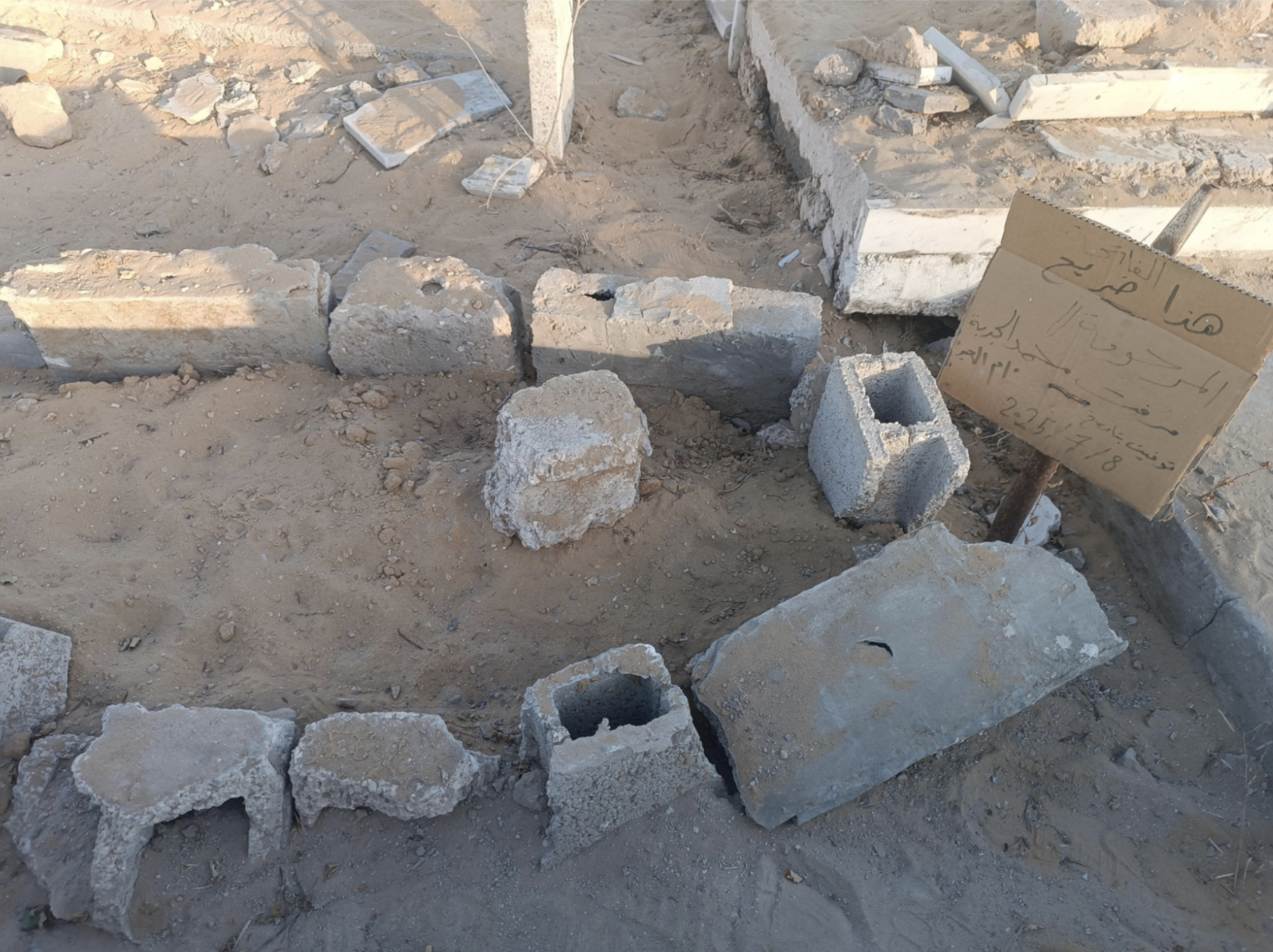How Gaza become a mass, unmarked grave
A torn piece of cardboard from an aid box marks a newly-dug grave made of broken cement blocks in Al-Nasr Cemetery, Gaza. Handwritten Arabic text identifies the grave as belonging to Mervat, buried on July 8, 2025 Photo taken by Sumaya Yasser Saleh, July 30 2025.
As I walk through the alleyways and streets of Gaza, I often ask myself, is the ground beneath my feet soil or someone's hastily dug grave?
I proceed cautiously. I am afraid of treading on a body that was never put to rest. What was their name? Did anybody cry for them? Does anyone even know they were killed?
Makeshift burials are increasingly the only kind of burials in Gaza. Many graves are completely unmarked — some make use of empty aid boxes, the front side with the martyr’s name, the back side, "UNRWA."
The official cemetery of Gaza City has been out of commission since October 2023. Euro-Med Monitor reported nearly a year ago that thousands of families continue to bury their children in mass graves, as Israeli forces target those who attempt to enter Gaza’s cemetaries.
In December 2023, my family was displaced from Jabalia Refugee Camp amidst the unrelenting shelling. An airstrike had hit a home three houses down from ours, so we decided to leave and hurried to the school complex. They claimed it was “safer”—but we all knew nothing was safe. We turned a corner and saw five men bending over a body and digging with their hands beneath a tree near the road. Someone was whispering verses. Another had tears streaming down his face. One simply stared at nothing.
As they were digging, a whistling noise veered past us, penetrating our flesh before we could even hear it. A shell landed just meters away between us and the grave diggers. They ran without looking back. I saw the body, still halfway out of the grave, as if it, too, realized it would not be permitted to rest. In Gaza, not even death itself shows mercy.
"Is this what we've become?" I thought to myself. “Who runs from the dead?” It is considered a war crime to prevent the respectful disposal of bodies during armed conflicts. And yet we are now forced to flee from our own funerals or face the same fate ourselves.
In October 2024, my cousin Khaled, 27, married with a young baby, was killed by a quadcopter drone that appeared out of nowhere and shot him to death.
We wrapped him in a thin, tattered blanket. We had nothing else, not even time. We excavated along the old kitchen wall, using dirt from out neighbor’s yard. The shovel was bent and my palms burned. My brother's lips twitched, but he didn't say anything as he dug alongside me. We buried our cousin the way people bury secrets: softly, quickly, and without names.
Then I sat beside the new mound and wondered: What type of society buries its children like stolen goods?
Though unmarked, unfinished and unritualized, Gaza’s graves etch themselves into our collective psyche. They don't endure through stone or inscription, but through our lived experiences of trauma: the erosion of rituals, the disappearance of names and the quiet unraveling of all dignity. They signal our erasure as a people.
The mass graves that litter Gaza’s landscape are yet another marker of genocide. The Euro-Med Human Rights Report has identified at least 30 mass graves across Gaza, containing the bodies of over 3,000 martyrs, in addition to at least 120 graves containing three or more people. These figures do not include those killed by incineration, buried under the rubble and all those unaccounted for who were given no burial at all.
In September 2024, I was walking in Jabalia near the al-Faluja Cemetery and I heard a loud gunshot. I followed the sounds to the cemetery, where the air was thick with the smell of death. A family was burying around 20 bodies, one on top of one another. The scene was chaotic as family members hurriedly dug with their hands, struggling to make space in a space overflowing with bodies.
The largest mass grave in Gaza is in the Al-Batsh cemetery, an improvised graveyard that was opened just two weeks after October 7, where it’s estimated anywhere between 500 and 1000 people have been buried. Israeli forces continue to wreak havoc on these sites, bulldozing, removing, and surfacing bodies — leaving some of the martyrs’ loved ones to report that their remains have ‘vanished.’
At the Nasser Hospital in Khan Younis, a mass grave of 392 bodies was uncovered in April 2024, and another of 42 bodies were found at al-Shifa Hospital in Gaza City. Corpses were found stripped and bound with clear sites of field executions, headless bodies and individuals with medical equipment still attached, and at least 20 martyrs with strong indications they were burnt alive. At al-Shifa hospital, Israeli tanks drove over tents, bulldozers flattened shelters and drones fired on those trying to flee. People were crushed alive, leaving behind pulverized limbs, the smell of decomposing bodies and a mass grave (1, 2, 3, 4) .
In Gaza, mass graves are not just deep pits in open fields, they’re scattered, silent, improvised and everywhere. They reflect the complete collapse of the physical, social and spiritual rituals that sanctify human life.
Subscribe to the Palestine Nexus newsletter:


